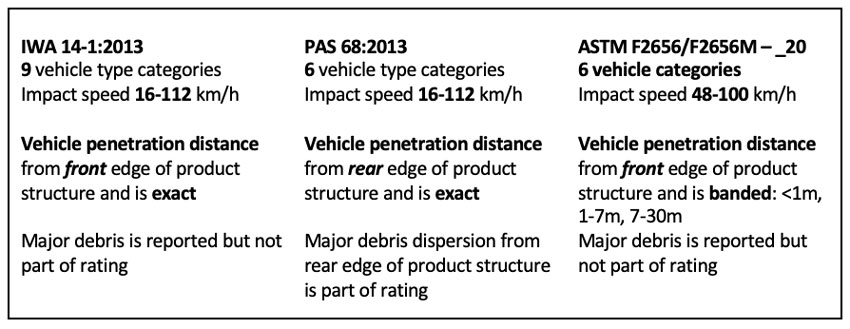Designed to Protect
TESTING FOR CONFIDENCE
When selecting a product to provide security, confidence in its performance is a must. A security bollard barrier system must be robust enough to resist impact from a vehicle with a specified weight and approach speed. Bollards that are built to meet standards provide confidence that a product will provide the proper level of resistance. Certification enables the design professional to make an informed, safe decision for their project and to protect a property owner against future risk of litigation.
Common Testing Standards
It is important to find the product that meets the standard most relevant to a project’s needs. Simply because a product meets a certification standard, that product does not necessarily provide the appropriate aesthetic and characteristics for a project. There are many different ratings systems and specification standards for bollards. However, there are typically three main variables that make up the rating: vehicle classification (size and weight), vehicle speed, and penetration distance.
The U.S. Department of State released the first vehicle barrier certification standard in 1985. This certification, known as a “K” rating, is a crash test certification issued by the Department of State to a fence, gate, barrier, or bollard. K-rated bollards are often referred to as ram, anti-ram, or anti-terrorism bollards. The rating describes the perpendicular impact penetration of a vehicle of a specific weight at a specific speed. The K-rating weight of the vehicle is standardized at 15,000 lbs. and can be compared in size to a box truck.
In 2003, the Department of State criteria was enhanced so that any barrier earning a K rating can only allow the truck to penetrate no further than 36 inches past the leading edge of the bed. A barrier with a K4 rating states that the bollard, in testing conditions, stopped a 15,000-lb. vehicle traveling at 30 mph within 36 inches or less. A barrier earning a K8 rating stops the same vehicle traveling at 40 mph and a barrier earning a K12 rating stops the 15,000-lb. vehicle traveling 50 mph in less than 36 inches.
The Department of State K ratings were superseded in 2007 by the introduction of American Society for Testing and Materials (ASTM) F2656. Today, the two most commonly used assessments in the United States are the American Society for Testing and Materials (ASTM) F2656/F2656M-20 and (ASTM) F3016/F3016M-19.

Photo courtesy of Forms+Surfaces
UK and European standards have been developed using test vehicles commonly found on UK and European roads, whereas the American standard is relevant to vehicles typical on its domestic roads. Vehicle shape is the most apparent difference between commercial vehicles and has a bearing on its construction, including chassis rail design and height; positions of axle, engine block, and load bed.1
ASTM F2656
Various standards are used to assess the vehicle impact performance of vehicle security barrier (VSB). ASTM standards include F2656, which tests for high-speed impact, and F3016, which addresses low-speed impacts below 30 mph.
Under ASTM F2656/F2656M-20, “Standard Test Method for Crash Testing of Vehicle Security Barriers,” the target of the standard is to guard against building penetration and establish a measure of performance. This test method provides a range of vehicle impact conditions, designations, and penetration performance levels. The results and ratings allow design professionals to select passive perimeter barriers and active entry point barriers appropriate for use at facilities with a defined moving vehicle threat. Condition designations and performance levels in this test method can be adapted to meet a project’s specific needs. Many test parameters are standardized to arrive at a common vehicle type and mass, and replication, and produce uniform rating designations.
Standard vehicle conditions under ASTM F2656-20:
- (SC) Small Passenger Car 2,420 lbs (1,100 kg)
- (FS) Full-size Sedan 4,630 lbs (2,100 kg)
- PU) Pick-up Truck 5,000 lbs. (2,100kg)
- (M) Standard Test Truck 15,000 lbs. (6,800kg)
- (C7) Class C Cab over 15,873 lbs. (7,200kg)
- (H) Heavy Goods Vehicle 65,000 lbs. (29,500kg)
Standard speeds (S): range from 30 miles per hour (mph) to 60 mph.
Based on the size of the vehicle and its speed, the generated impact conditions are also assigned a dynamic penetration rating (P):
- P1 ≤ 1 meter (3.3 ft)
- P2 = 1.01 meters (3.31 ft) to 7 meters (23.0 ft)
- P3 = 7.01 meters (23.01 ft) to 30 meters (98.4 ft)
As an example, a security bollard with an M50-P1 rating would be predicted to stop a Standard Test Truck (M) of 15,000 lbs, traveling at 50 mph (50), in less than 1 meter (P1) after the truck makes initial contact with the bollard.
While the K ratings from the original Department of State standard were replaced by ASTM F2656, there are corresponding ratings: a rating of K12 is equal to M50 under ASTM F2656; K8 is equivalent to M40 and K4 is equivalent to M30.
The design professional needs to be aware that ASTM F2656-20 states that the tested product must be installed into a low cohesive compacted soil, unless specified for a site-specific installation. When the selected bollard is installed, the team should always be aware of the ground conditions and supporting foundation used for the impact test and assess whether they are comparable with their site ground conditions. Products that carry a rating, should be accompanied with approved installation instructions. Following these instructions from a vendor is paramount to achieving the specified rating.









